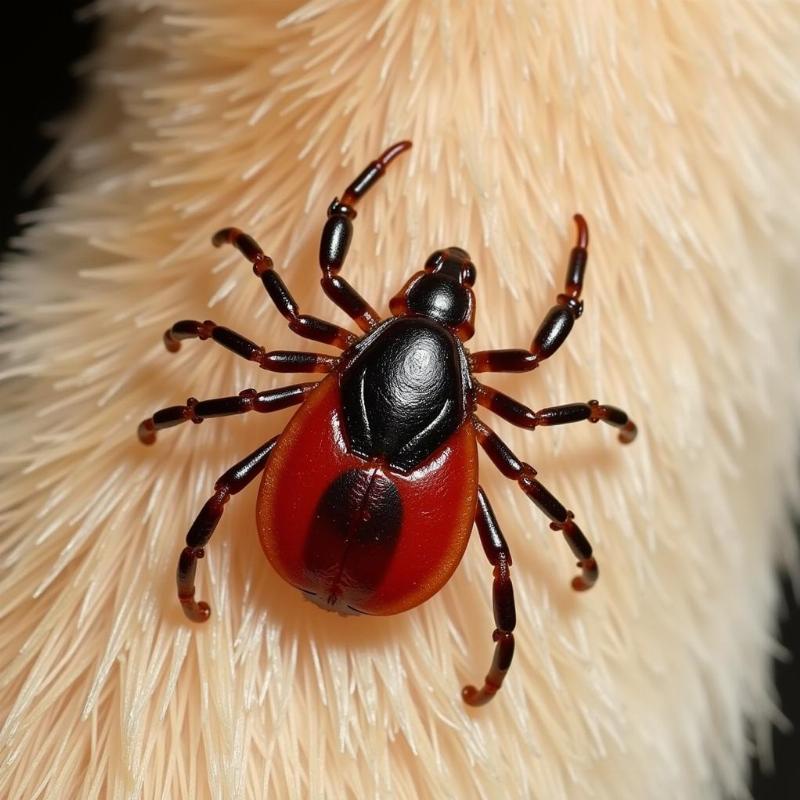Finding a little black bug on your dog can be alarming. These pests can range from harmless scavengers to parasites that cause serious health issues. This article will guide you through identifying common “little black bugs” found on dogs in the US, understanding the potential risks, and outlining effective treatment and prevention strategies.
Common Culprits: Fleas, Ticks, and Lice
Several tiny black bugs can infest our canine companions. Let’s explore the most common culprits: fleas, ticks, and lice. Each of these parasites requires a specific approach to identification and treatment.
Fleas: The Tiny Jumpers
Fleas are small, dark brown to black insects known for their jumping ability. They feed on blood and can cause intense itching, skin irritation, and even allergic reactions. A telltale sign of fleas is “flea dirt,” which looks like small black specks resembling pepper. This is actually flea feces, and if you place it on a damp paper towel, it will turn reddish-brown from the digested blood.
Ticks: The Bloodsuckers
Ticks are another common external parasite. They vary in size and color, but many appear as small, dark brown or black bumps on your dog’s skin, especially after feeding. Ticks can transmit serious diseases like Lyme disease, Rocky Mountain spotted fever, and ehrlichiosis. Regularly checking your dog for ticks, especially after walks in wooded or grassy areas, is crucial.
 Engorged Tick on Dog
Engorged Tick on Dog
Lice: The Crawlers
Lice are less common than fleas and ticks, but they can still cause significant discomfort. These tiny, wingless insects crawl on the skin and feed on debris and sometimes blood. Lice infestations can lead to itching, hair loss, and secondary skin infections.
Treatment and Prevention Strategies
Once you’ve identified the type of “little black bug” infesting your dog, you can implement effective treatment and prevention measures. Consult your veterinarian for a proper diagnosis and tailored treatment plan. They can recommend appropriate flea and tick preventatives, medicated shampoos, and other treatments for lice infestations.
Protecting Your Home and Yard
Besides treating your dog, it’s essential to address the environment. Regularly wash your dog’s bedding in hot water and vacuum your home thoroughly to remove fleas, ticks, and their eggs. Yard treatments can also help control tick populations.
What to do if you find a little black bug on your dog?
If you find a little black bug on your dog, the first step is to try to identify it. If you suspect it’s a flea, tick, or louse, contact your veterinarian. They can confirm the diagnosis and recommend the best course of action.
Why are these bugs attracted to my dog?
These bugs are attracted to your dog for a variety of reasons, including their body warmth, the carbon dioxide they exhale, and the presence of blood or skin debris.
Can these bugs transmit diseases to humans?
Yes, some of these bugs, particularly ticks, can transmit diseases to humans. This is why it’s crucial to prevent infestations and seek veterinary care if you suspect your dog has parasites.
Further Reading
If you’re interested in learning more about dog health and wellness, explore these related articles on Beautdogs.us: (No related articles found)
Beautdogs.us is your premier resource for all things dog-related in the US. We provide expert advice on dog breeds, care, and products. Whether you’re a seasoned dog owner or just starting out, Beautdogs.us has the information you need. Contact us today to learn more! Email: [email protected], Phone: +1 501-555-7529. Visit Beautdogs.us for expert guidance and premium products for your beloved canine companion.